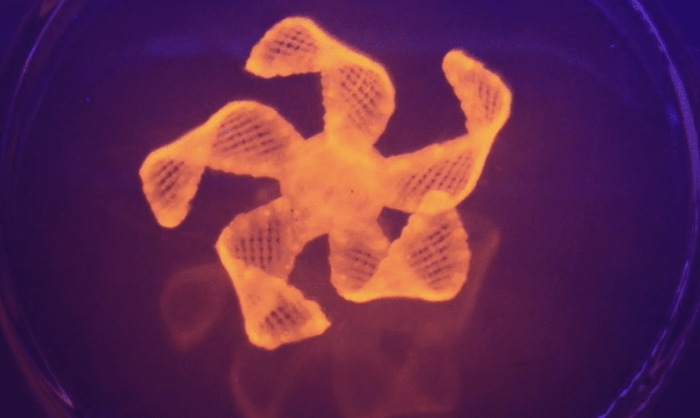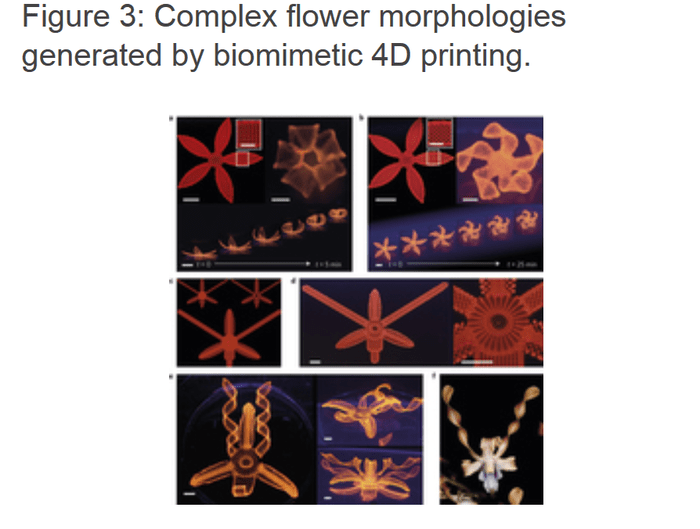4D Printing To Be A Reality Soon: Harvard Researchers Create Shape Shifting Architectures
A group of scientists at the Wyss Institute for Biologically Inspired Engineering at Harvard University and the Harvard John A. Paulson School of Engineering and Applied Sciences (SEAS) scaled up their contemporary 3D micro-printing technology to time, the fourth dimension. The research was reported in “Nature Materials†journal under the title “Biomimetic 4D printingâ€.
Jennifer Lewis, senior author of this new mechanism explained that the work represented an elegant advance in programmable material assembly, an output generated due to a multidisciplinary approach. The 4D printing idea is based on nastic plant motions due to external stimuli such as humidity, light, touch etc. Morphologically speaking, tissue composition and microstructures of flowers and plants have a dynamic structure that allows them to move according to the environment. With this 4D technology, products will be more “lively†and enjoy more autonomy.

Moving 4D Printed Flower like structure
Inspired by botanical systems, the team printed composite hydrogel architectures which are programmed to contain precise and localized swelling. Consisting of wood derived cellulose fibrils, the hydrogel composite ink is encrypted with anisotropic swelling and stiffness which can be manipulated to form different patterns and structures. The anisotropic nature of the cellulose fibrils gives carried directional properties which can be seen if the structure is investigated under water. When immersed, the hydrogel-cellulose fibril ink undergoes differential swelling along and orthogonal to the printing path.
Matsumoto, one of the members claimed that their mathematical model predefines the printing pathways required to achieve the desired shape. He added that their program, based on a proprietary algorithm can tilt the curvature both discretely and continuously giving the user more control on the product. They also managed to tackle the “inverse problem†and thereby predicted what tool path gives the desired shape.

This remarkable advancement of technology allows creation of any product decreasing their movement restriction and escalating their dynamics. Scientists claimed that integration with other processes would help in smart autonomous robotics in textile industry, biomedical devices, drug delivery and tissue engineering to produce more efficient results. This work was supported by funding from the Army Research Office and the National Science Foundation’s Materials Research Science and Engineering Center.
Watch 4D printing Shape-shifting architecture here:
Source: <a href="https://news.harvard.edu/gazette/story/2016/01/4d-printed-structure-changes-shape-when-placed-in-water/" target="_blank" rel="nofollow noopener noreferrer">4D-printed structure changes shape when placed in water – Harvard Gazette</a>|#-Link-Snipped-#
Jennifer Lewis, senior author of this new mechanism explained that the work represented an elegant advance in programmable material assembly, an output generated due to a multidisciplinary approach. The 4D printing idea is based on nastic plant motions due to external stimuli such as humidity, light, touch etc. Morphologically speaking, tissue composition and microstructures of flowers and plants have a dynamic structure that allows them to move according to the environment. With this 4D technology, products will be more “lively†and enjoy more autonomy.

Moving 4D Printed Flower like structure
Matsumoto, one of the members claimed that their mathematical model predefines the printing pathways required to achieve the desired shape. He added that their program, based on a proprietary algorithm can tilt the curvature both discretely and continuously giving the user more control on the product. They also managed to tackle the “inverse problem†and thereby predicted what tool path gives the desired shape.

This remarkable advancement of technology allows creation of any product decreasing their movement restriction and escalating their dynamics. Scientists claimed that integration with other processes would help in smart autonomous robotics in textile industry, biomedical devices, drug delivery and tissue engineering to produce more efficient results. This work was supported by funding from the Army Research Office and the National Science Foundation’s Materials Research Science and Engineering Center.
Watch 4D printing Shape-shifting architecture here:
Source: <a href="https://news.harvard.edu/gazette/story/2016/01/4d-printed-structure-changes-shape-when-placed-in-water/" target="_blank" rel="nofollow noopener noreferrer">4D-printed structure changes shape when placed in water – Harvard Gazette</a>|#-Link-Snipped-#
0
